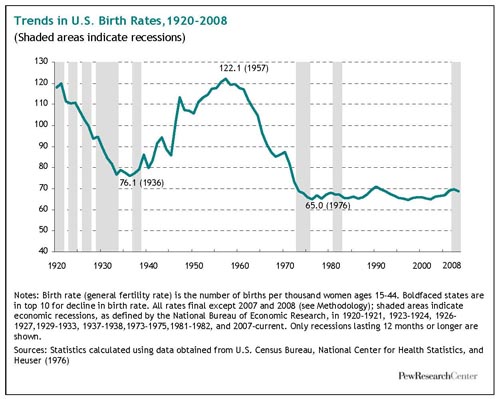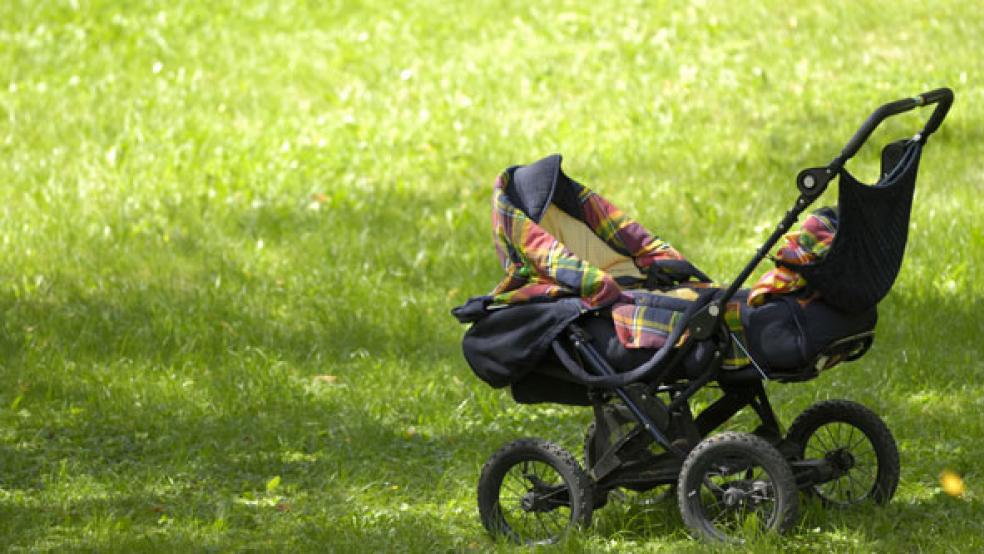This is the first piece in a series that will examine the impact of a potential baby dearth in America. The recession is pushing the birth rate down, women are waiting longer to have children and the cost of raising a child is skyrocketing. Fewer babies means fewer young people to support an aging population , threatening already-strained social programs. Has America’s baby bubble burst?
2.1 . That’s how many babies per woman it takes to replace the population. In the U.S., this number was holding steady until 2008, when it fell to 2.08; in 2009 it dropped to 2.01 — the largest dip since the 1970s. The ‘60s brought the baby boom and a prolific 3.7 births per woman, but today we’re facing a baby bust. One of the striking and less-reported trends the Great Recession has brought is a decline in the birth rate, which some experts predict will continue to fall. When it falls over a long period of time — as it has in nearly every other developed country — governments face the dire consequences of having a small working public supporting an aging population — a combination that could topple not only social programs for the elderly, but the entire economy.
America’s population growth is now at its lowest
level in seven decades.
Back in 2007, it was business as usual. The U.S. had the highest birth rate since the baby boom, with 14.3 births per 1,000 people. But in four years of economic slump, that number has fallen over 8 percent. A 2009 Pew Research Center survey reported 14 percent of people in their prime childbearing years put off having a child because of the recession. The 2010 Census found that America’s population growth is now at its lowest level in seven decades, growing 9.7 percent over the past 10 years, down from 13.2 percent from 1990 to 2000, and the lowest since the 7.3 percent during the Great Depression.
Broken down by state , the largest birth rate declines were in states with the greatest job loss and foreclosures: Arizona’s birth rate declined 7 percent, Florida’s by 5 percent and California’s by 4 percent.
| Birth Rate by State | |||
| State | Birth Rate Change (%) 2007 - 2008 | Per Capita Income Change (%) 2006 - 2007 | Per Capita Income Change (%) 2006 - 2007 |
| California | -2.8% | 1.5% | -2.1% |
| Arizona | -4.6% | -0.1% | 1.7% |
| Florida | -2.8% | -0.5% | 0.9% |
| New Hampshire | -2.2% | 1.6% | 0.1% |
| Michigan | -1.6% | 0.1% | -1.8% |
| Data: Pew Research Center | |||
The reason? A deep recession that causes financial instability and uncertainty can deter people from having children. “[Births] may fall for couples that experience layoffs, unemployment, or other financial loss, but it also can fall for all couples because of a general sense of economic uncertainty about the future,” says Ronald Lee, a demography and economics professor at University of California, Berkeley.
As a society moves away from farm-based living to
big cities, children go from being an economic
asset, to a burden.
“When the economy gets bad enough,” says Phillip Longman, author of The Empty Cradle: How Falling Birthrates Threaten World Prosperity And What to Do About It, “people can’t even imagine absorbing the direct costs of having a kid, whether they’re employed or not. That’s when birth rates go down.” At the moment, at least, babies are on the back burner, but the question many are asking is, could the Great Recession have kick-started a longer-term baby dearth? Or will having a baby be de rigueur if and when the economy fully recovers?
The Shrinking Workforce
A developing country almost always sees falling birth rates. As a society moves away from farm-based living to big cities, children go from being an economic asset to a burden. Urbanization, education and increased cost of living all contribute to lower birth rates. In the mid-1800s, women had six children on average, well above the 2.1 replacement rate. Though many of them died of childhood diseases that no longer threaten the population, and others lost their lives to war.
When the birth rate declines, the next generation of young, inventive entrepreneurs that America is known for, shrinks. Seventy-seven million baby boomers will be retiring in the next two decades and living longer (thanks in part to the expensive tax funded health care system that treats them). The U.S. simply can’t afford further decline in population growth. A small workforce means plummeting tax revenues, Social Security reserves and Medicare revenues, causing havoc to the entire system.
One expert calculated that the last Japanese baby
will be born in the year 2959.
Western Europe, East Asia and Canada have already experienced falling birth rates with depressing results. Japan’s baby dearth, which started in the mid-1970s, has contributed to deflation, high unemployment and economic decline in the 1990s. In that time, government expenditures on social services skyrocketed, going from about 6 percent of GDP in the 1970s to 18 percent in 1992. By 2015, a full quarter of the population will be over 65. By 2050, it could be as high as 40 percent, turning the country into one giant nursing home. One expert calculated that the last Japanese baby will be born in the year 2959. Some demographers believe the Soviet Union’s collapse was partly due to low birth rates.
Though this may sound like an apocalyptic scene from a P.D. James’ The Children of Men, a science fiction novel about a childless, destitute society, the good news is the U.S. stands out among developed nations — its birth rate hasn’t fallen nearly as far or as fast as others, partly because immigrants and their descendents pick up the slack and help keep the workforce robust. Some say it’s the large religious populations in the U.S. which consistently produce more children. Lee at the University of California speculates it was the “open frontier [of America] that worked its way into the cultural perception of economic opportunity.”

Yet despite these forces, the U.S. seems to be heading down the same barren path as other low-birth rate countries. Like in Europe and Canada, American women are waiting longer to have children, more women are skipping out on motherhood altogether, and the costs of raising children are soaring. Raising a child is now estimated to cost $10,000 per year. Among parents who decided to limit their family size, 72 percent said they were worried about the costs of raising a child, according to a Pew Research Center survey.
The youth population growth was completely
propelled by Hispanics, and without them, the number
of young people in the U.S. would have declined.
What’s more, America’s higher 9.7 population growth from 2000 to 2010 wasn’t from fruitful long-time citizens, but mainly from the high number of immigrants entering the country. According to a Pew Research Center population prediction, 82 percent of population growth from 2005 to 2050 will be from immigrants and their descendants. From 2000 to 2010, the youth population growth was completely propelled by Hispanics, and without them, the number of young people in the U.S. would have declined. A recent CBO study found that in 1994, 1 in 10 people in the U.S. labor force were born elsewhere, but by 2009, it was 1 in 7. But because of the recession, that’s changing.
Illegal immigration is at its lowest point in the past two decades. Illegal immigration from Latin American countries — typically cultures known for their large families — declined the most, dropping 22 percent from 2007 to 2009. The dearth of jobs in construction and other labor industries, along with stricter immigration practices in Arizona and elsewhere, has led to more than a million immigrants from Mexico and Latin America returning home in the past two years.
For the immigrants that do enter the country, birth rates are falling for them as well. Fertility among Hispanic women dropped 6.1 percent and Asian fertility fell by 4.8 percent. “Fertility for non-Hispanics has typically been a little bit higher than in other industrial countries, and now fertility is falling so rapidly in most of the immigrant-sending countries that I don’t think that it’s going to be a force in the future,” says Lee.
A System in Peril
One thing is clear: A low birth rate is detrimental to expensive government programs like Medicare and Social Security. A recent CBO report found that Social Security’s trust fund will hit zero by 2037, thanks to the flood of retiring baby boomers. A low birth rate will only make it worse, rapidly accelerating the negative balance after the funds are exhausted.
“The ratio of workers to beneficiaries is projected to decline, even as the economy recovers, because the workers of the baby boom generation are being replaced in the workforce by relatively low-birth-rate generations,” the authors of a 2010 Trustees Report by the Social Security Administration write. “Certain population characteristics, such as the higher percentages of women who have never married, of women who are divorced, and of young women who are in the labor force, are consistent with continued lower total fertility rates.”
“As a population starts shrinking,” says Longman, “then socialist schemes of redistribution suddenly become very problematic.”
In our next article, we’ll explore the cultural drivers behind falling birth rates, and what it will mean for government programs and the economy. We invite you to participate in a discussion on whether you think the baby bust is here to stay.
Related Links:
Did Baby Boomers Notice The Baby Bust? (NPR)
Room in the Crib: Baby Population Slowing (MSNBC.com)



